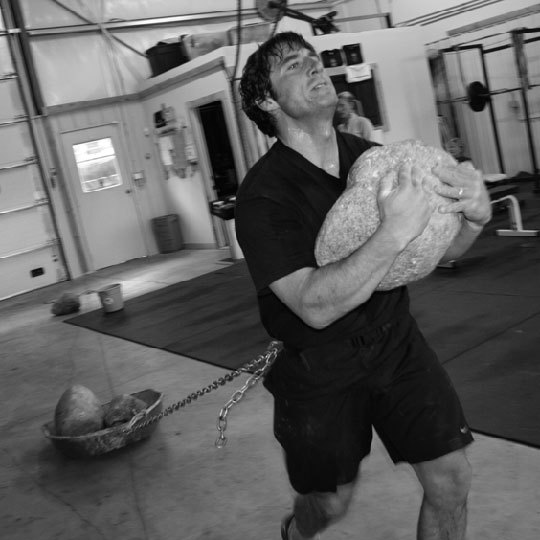
Exum Mountain Guide Christian Santelices hauling rocks at Mountain Athlete, an experimental training facility in Jackson, Wyoming, opened by self proclaimed gym rat Rob Shaul.
Editor’s Note: Thanks to Rob Shaul for his commitment to physical fitness as it relates to climbing, and specifically for sharing this introspective, in-depth look at his evolving regimen and facility. Visit www.mtnathlete.com to learn more.
Serious alpine firepower inhabited the gym Monday night.
Teton climbing legend, Avalanche Institute Founder, and Exum Senior Guide Rod Newcomb, in his mid-70s and shirtless, was firing through sets of sit-ups holding a 25# plate.
Rob Hess, third American to summit Everest without supplemental oxygen, 2007 AMGA Guide of the Year, and part owner of Jackson Hole Mountain Guides pounded out sets of ten body-weight dips, eyes blazing.
Up-and-comer Andy Bardon, 6’4″, 190 pounds, whose sole reason for living in Jackson is to mountaineer, attacked the tire drag–having loaded it with 80-pound sand bags–while carrying a water-filled keg over his head.
Brendan O’Neill suffered through walking lunges holding 75 pounds in kettlebells. The two-time North American ski-mountaineering champion has climbed El Cap in a day and redpointed 5.13, but this was just his third session in the gym, and he’s still acquiring an appetite for this intensity of training. On the platform Nat Patridge pulled set after set of light dead lifts, drilling form. The senior Exum Guide is an incredible skier–the former director of Jackson Hole Alpine Guides, Jackson Hole Mountain Resort and Avalanche forecaster/guide for High Mountain Heli-Skiing, Jackson Hole and Valdez Heli-Ski Guides, Alaska. Nat can strap on a pair of boards and drop off into a 55-degree couloir no problem, but he’s a relative newbie in the iron game, and he’s still dialing his dead lift technique.
My own mountain resume is pathetically thin. I’ve rock climbed maybe six times in my life. And even though I grew up skiing, I’d rate my ability after three decades as “stuck in the intermediate range.”
Yet there I was barking instructions, coaching, cajoling and encouraging these world-class alpinists and Jackson Hole mountain elites to add weight, lift more, drag faster, work harder and demonstrate some friggin’ mental toughness.
The Gym
I grew up in Pinedale, Wyoming, an hour south of Jackson, and have been a gritty gym rat since I was 12 years old. Over the years I’ve helped dozens of new lifters with technique and programming in the gym, and eventually I was certified as a strength and conditioning coach. I looked to Jackson to open a gym and got it into my head that I wanted to train mountaineers. I rented an industrial warehouse, put down rubber flooring, bought a few barbells, and named my gym “Mountain Athlete Strength and Conditioning.”

Christian Santelices climbing a notch on Mt. Shuksan in the Cascades during his AMGA Alpine Guide’s Exam. Santelices notes that his endurance and recovery time greatly improved due to training at Mountain Athlete, helping him stack big days in the mountains. [Photo] Christian Santelices collection
This wasn’t a “build it and they will come” type of deal. There is no strong tradition of alpinists conditioning themselves in the gym for events on the rock. Indeed, even now when many of the top US climbers and mountaineers are asked how they train, they respond, “I just climb.” And perhaps they go for long cardio runs or bike rides.
There are exceptions. Back in the day John Bachar managed his own outdoors gym complete with barbells and other weight-lifting equipment in Yosemite. I understand Todd Skinner hammered the weights, and I’ve heard stories about Alex Lowe’s brutal training sessions.
I owe Mark Twight greatly. In Extreme Alpinism Twight outlines a gym-based, strength and conditioning program for mountaineers, and has since enhanced that greatly through his Salt Lake City gym, Gym Jones, and website, www.gymjones.com. Mark’s mountaineering accomplishments, and his connected belief in gym training, helped give my program a thread of credibility when I first started out and spoke with skeptical mountaineers. From the beginning Mark and his wife, Lisa, have been very supportive.
It took some convincing. The Jackson climbers I initially approached to train in the gym blew me off completely, put off by my own mountain inexperience and an aversion to weight training.
So I approached Exum Mountain Guides and Jackson Hole Mountain Guides offering to train their guides in exchange for feedback on how my programming affected performance in the mountains.
Even with this deal, just a handful of guides from Exum, and only Rob Hess, owner of JHMG, took up the offer. Many came into the gym bringing decades of high-level athletic accomplishment, but little to no weightlifting experience. Just about all had a bias against training inside, and stereotypes of what “weight lifters” looked and trained like.
The fact that my gym lacks the mirrors, weight lifting machines, aerobics room and cardio equipment of typical commercial gyms helped. Also, we only train in small group sessions, so the doubtful mountaineers trained alongside others just like them. Camaraderie blossomed.
But for the uninitiated, our training sessions can be simply crushing. Some leave the gym after their first workout with the look of shock on their face and never come back; others walk out with that same shock, know our stuff is the real deal, and can’t get enough.
Soon after opening we began to draw inquiries from local climbers not involved in guiding. The most persistent was Andy Bardon, a young mountaineer. Andy hit it hard, liked it, and started dragging two of his climbing partners, Will Wetzel and Neil Grimwaldi, to the gym. I sponsor all three of them–they’re my best guinea pigs. I push them harder than any other athletes.
Two female climbers, Tina Flowers and Connie Sciolino, are attached to Exum through marriage but aren’t guides themselves. Connie, especially, is a driven climber, and joined the gym with the sole purpose to improve her climbing.
Training Goals
Mountaineering is physically demanding in various ways. Heavy packs and long approaches take strength. Long, vertical, challenging leads demand power endurance. Bad weather, route challenges and pure hunger require mental toughness. Climbing itself, and being ready for the unexpected, require full-body strength and well-rounded fitness.
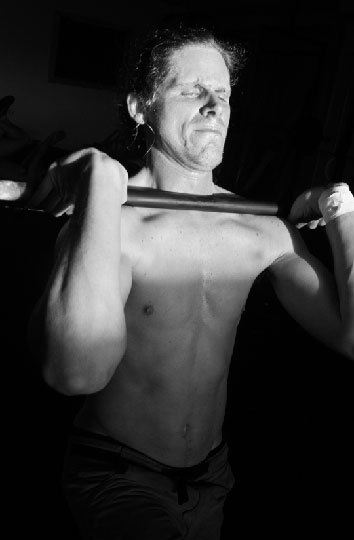
Neil Grimaldi working hard at Mountain Athlete. Rob Shaul utilizes traditional as well as creative strength and conditioning techniques when designing workouts.
In response I created a hybrid training program designed to increase an athlete’s work capacity and build his or her horsepower. I drew on methodology and programming gleaned in part from coaching giants Dan John, Mark Twight, Greg Glassman, Mike Boyle, Alwyn Cosgrove, Mark Verstegen, Louie Simmons, Ethan Reeve and Greg Everett.
We employ classic barbell exercises such as the dead lift, front squat and bench press to build strength. Power cleans, push presses, and basic plyometrics are used to increase explosive power. CrossFit-inspired, super-intense circuits and classic interval training drive metabolic conditioning and cardio. Long, moderate weight, high-rep “grinds” develop strength endurance.
Overall the goal is to build horsepower and staying power so our athletes can go faster farther, feel stronger longer and be mentally tougher on the mountain.
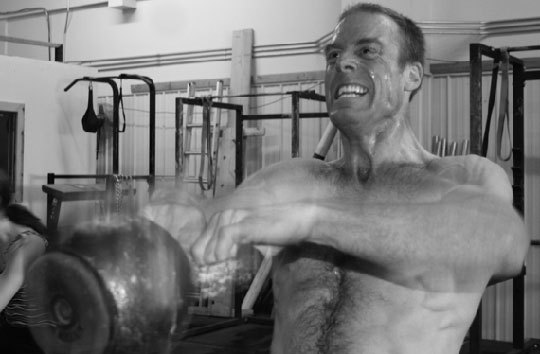
Stephen Koch swinging a kettle bell at Mountain Athlete.
Strength is King
Most of the guides and climbers looked very fit and moved well but were pathetically weak by gym standards.
My guides could easily handle back-to-back one-day ascents of the Grand Teton, but struggled to dead lift their body weight, or do three sets of ten basic push-ups. Classic exercises like Turkish get-ups and one-arm bench presses identified glaring strength and muscle imbalances. Several were even weak doing sport-specific exercises like pull-ups.
The best thing I can do for my athletes is get them stronger. Strength is the foundation of athletic ability, and I saw it as not only increasing performance, but also adding durability, or resistance to injury.
I do not train body builders or power lifters. I understand that mountain athletes must not only be strong, but also light to move well on rock and snow. I aim to get them stronger without making them heavier.
As a result our strength goals revolve around relative strength–that is, strength in proportion to body weight. My strength standards for men include a 2x body-weight dead lift, 1.5x body-weight front squat and bench press, 1.25x body-weight power clean, 1x body-weight military press, twenty strict body-weight pull-ups, and forty strict body-weight dips (strict meaning full range of motion; no cheating).
Dead lifts, front squats, power cleans and push presses–the classic barbell exercises for developing full body strength–formed the cornerstone of my strength-training program. We drilled body-weight pull-ups, push-ups and dips to begin developing upper-body strength. I have a dozen body-weight and loaded mid-section exercises that often employ kettlebells for improving core strength.
Strongman training complemented classic barbell and body-weight strength training exercises. My athletes drag tires, throw sledgehammers, sprint with sand bags and walk carrying heavy rocks.
Both male and female athletes do the same exercises.
Power Endurance, Strength Endurance, Mental Toughness
Stronger, longer is the goal. Developing the ability to stay strong for extended periods of time can be as much a mental task as physical ability and stamina. Extended bouts of cardio-respiratory and muscular stress at high, but sub-maximal levels perhaps best mirror mountain events. Muscles burn. Chest heaves. The mind grows weak. Power endurance and strength endurance give the alpinist the ability to keep on moving, no matter what.
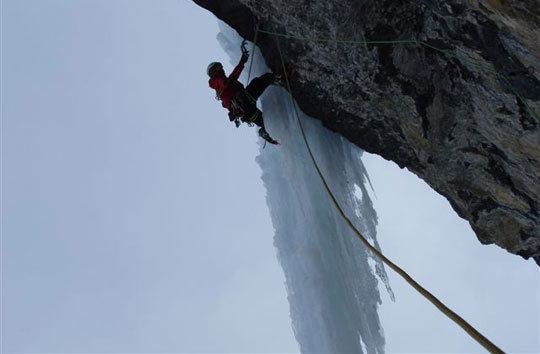
Stephen Koch digging into Nightmare on Wolf Street (M7+ WI6+ l80m),
Stanley Headwall, B.C., Canada. Climbed on March 10, 2008. Koch
began training at Mountain Athlete in the spring of 2007. Koch had been dealing with a herniation of his back for several years before working out at Mountain Athlete. He believes his increased core strength from attending Mountain Athlete training sessions has resulted in less injuries.
[Photo] Jack Jefferies
Our power endurance training focused on intervals and intense metabolic conditioning circuits. These events often last fifteen to twenty minutes and, in a word, suck. A good example is a workout we call “Girl Farts,” which involves rowing 5500 meters on a Concept 2 rower, and doing fifty-five “Renegade Man Makers”–a push up, squat and push/press combination exercise performed holding two 25# dumbbells for men, and two 15# dumbbells for women. (Note: Women do the same exercises and same number of reps as men, but usually with lighter loads. Some of my female athletes use higher loads than new male athletes.)
When done all out, the athletes’ muscles and lungs fail at just about the same time. Pushing this intensely is very uncomfortable. This type of training takes serious mental toughness.
Taking the lead from Greg Glassman and CrossFit, I used the stopwatch and competition as an effort motivator. One thing climbers are is competitive. All I had to do to push the intensity level was give a handful of them the same workout, pull out the stopwatch, and say “3-2-1-GO!”
Mountaineers know how to suffer, but this was something different. It took time for some of the guides and regular climbers to grow accustomed to this level of intensity before they developed the mental toughness to truly push as hard as they could.
Results
Monitoring the results of our training program revolves around frequent one-rep maximum strength tests of our core barbell exercises, and timed results on intense benchmark power endurance workouts.
One of the great things about being a new lifter is your strengths come fast and easy. My athletes were no different.
Exum Guide Brian Harder is a good example. With just six months of training, his maximum bench press went from 190 pounds to 235, his front squat increased from 115 pounds to 235, and his dead lift grew from 185 to 360 pounds.
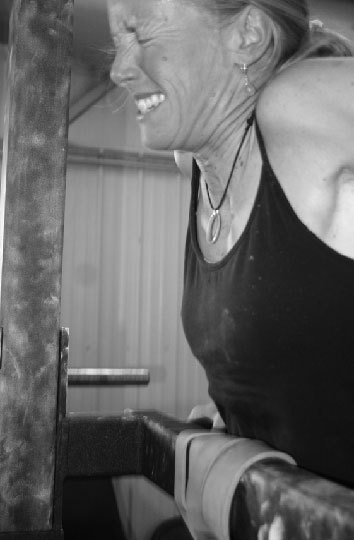
Kim Young pushing through the pain at Mountain Athlete. Women do the same exercises and same number of reps as men, but usually with lighter loads. Some veteran female athletes use higher loads than new male athletes.
Rob Hess saw his front squat increase from 145 pounds to 215 and his dead lift increase from 235 pounds to 305.
Stephen Koch’s bench increased from 150 pounds to 195, his front squat from 135 to 225, and his dead lift from 250 pounds to 335.
Andy Bardon and Will Wetzel have each added significant horsepower, especially in overall upper-body strength. Connie and Tina are two of my best performers, often crushing men unlucky enough to train in the same session and foolish enough to try to keep up.
We saw similar improvements, though not quite as dramatic, in the performance on our power endurance workouts. Rarely, during a regular benchmark workout, is an athlete’s time not improved significantly over the previous effort. Increased strength has a lot to do with this. Between benchmark power endurance workouts–usually moderate weight, high-rep strength exercises–we will have several training sessions aimed at improving raw strength by lifting heavy. This makes my athletes stronger. Also, the more of these power endurance workouts my athletes complete, the more they become accustomed to working this intensely. Their mental toughness increases accordingly, and they are able to complete workouts faster.
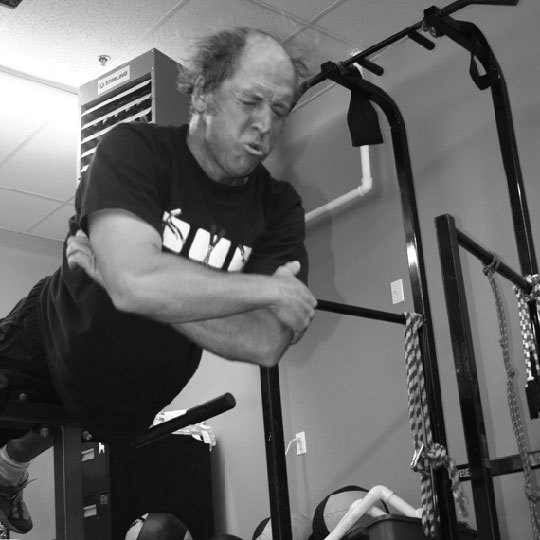
Rob Hess performs back extensions at Mountain Athlete. Jackson Hole Mountain Guides part owner, 2007 AMGA Guide of the Year, and third American to summit Everest without oxygen, Hess knows how to suffer.
Feedback
We began training guides in the early spring of 2007, and at the end of the summer I solicited feedback. Several of the guides pointed to feeling “stronger” and because of that strength, feeling “more confident” on the mountain.
Exum’s George Gardner is a good example. He hit the training hard early in the summer, grew stronger and reported an increase in confidence. Even though George is in his mid-50s he logged more guided Grand Teton trips last season than any other Exum Guide.
“I feel more confident in my abilities as a guide, and understand better my limits,” reported Christian Santilices. “I know how strong I am now. I can calculate more effectively what I think I can hold, for example, short roping two people based on what I have done in the gym. When climbing hard, I feel like I can hold on longer figuring out a move. There is no desperation. My improved muscle strength and endurance means that I can take my time to work out a move, and I also have the ability to move through difficult sections more fluidly and with more confidence. This allows me to demonstrate tough moves to clients with greater effectiveness. I do my job better because of the work I have put in.”
Angela Hawse provided similar feedback. “I definitely feel more confident than before. Feeling stronger and knowing that I am stronger definitely adds that confidence. Also the mental intensity of the workouts and pushing through the pain was definitely a benefit that I feel in the mountains. Often times the crux sections are short, and having that confidence to push through seems enhanced since I have done the training with you.”
Stephen Koch added that Mountain Athlete training makes him stronger, “which means I am able to climb faster and harder, which translates to more options for climbs and descents and to a safer mountain experience.”
Not all the feedback was positive. A few of the guides and climbers simply never bought into the training program, became comfortable with the heavy lifting and intensity of workouts or sustained injuries and stopped training in the gym. It’s become clear that this stuff isn’t for everybody. Nagging lower back pain and cramping was one source of the stoppage. Forearm and wrist pain, and shoulder issues also caused some guides not to train. On a couple of occasions, the minor injuries lifting in the gym, or deep soreness from the workouts simply scared athletes off.
Limitations and Lessons Learned
One hole in our program climbers identified was the lack of grip/forearm strength and endurance training. Angela Hawse and especially Stephen Koch identified this missing link. In response this winter we began intensive strength, power and endurance grip training sessions at a local rock gym.
We provide an elite-level overall fitness program, but it is still general, something pointed out by guide and competitive ski-mountaineer Brian Harder. After training in the gym all summer and fall Brian’s performance on the first group of ski-mountaineering races was behind his performance in 2007. He subsequently cut way back on his gym training, and began an intensive sport-specific training program including long days skinning and skiing, and skinning intervals. By the end of the season, he was back in top form.
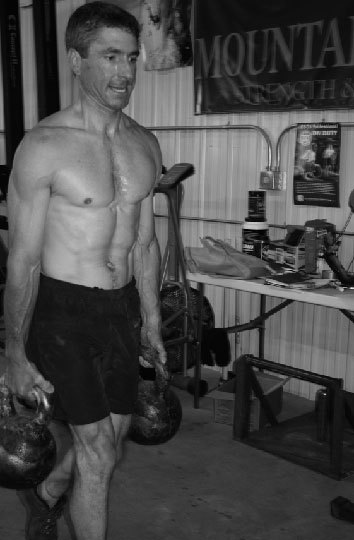
Mark Newcomb carrying kettle bells at Mountain Athlete. Newcomb is an Exum Guide with a resume that boasts big first ascents including Sepu Kangri (22,800’) in Western China.
Concerns about getting injured were definitely an issue with several of the guides, and it made me realize that these were “industrial athletes” in the sense that they used their bodies to earn a living. Injury meant money out of their pocket. This realization also caused me to think not only in terms of performance, but also durability. Of all the guides I trained last summer, just one, Bean Bowers, was training for a major climb and expedition. The remainder of the senior guides just wanted to survive the busy guiding season and have enough juice left to have fun climbing in the desert that fall.
Durability translates into injury prevention. Studies have shown that in industrial athletes like firefighters, muscle imbalances, overall weakness, core weakness, hip mobility, and overuse issues all lead to higher injury rates. As a result, we have begun adding mobility drills, and joint/muscle activation exercises to our programs while also taking a more patient approach to building strength.
Because we don’t use weight-lifting machines, our exercises are performed standing up, in free space. This type of lifting really works and builds the core and midsection, the source of overall body strength and durability.

Will Wetzel squatting at Mountain Athlete. Wetzel has been training with Rob Shaul’s program since summer 2007.
Does it Work?
Early on I understood transferability is key. Training in the gym, which doesn’t increase performance or durability on the mountain, is a waste of time.
Eric Horst, author of Training for Climbing and How To Climb 5.12 does not believe in general fitness training for climbers. His training is all sport specific.
Black Diamond-sponsored climber Rob Miller disagrees. Rob is an avid follower of CrossFit and a coach himself. He argues that an intense, general fitness program transfers well to climbing.
The fact that the Exum Guides who stuck with the program also happen to be among the most accomplished and senior guides demonstrates some value in our programming and in the idea that hybrid training can improve climbing performance.
But the most direct feedback came from my non-guide climbers. Andy Bardon reported climbing at a much higher level in Yosemite after several months of training at Mountain Athlete without any additional training. He has since climbed at Yosemite a second time, and wrote me after returning, “I can say without ego or emotion that I am stronger than I have ever been.”
Connie Sciolino reports that the training at Mountain Athlete has made her stronger, but more importantly given her the confidence to begin lead climbing.
Looking Ahead
Our partnership with Exum Mountain guides continues into this new season, and several of the guides, who live somewhere else during the winter, will be rolling back into town and the gym this month to begin the guiding season, and training in the gym.
I don’t advertise, but through word of mouth in Jackson, our website, and local and national press coverage, Mountain Athlete is developing a strong reputation for effective, intense mountain training. More and more non-guide climbers are knocking on the door or e-mailing questions and comments.
We also have branched to train outdoors athletes in non-mountaineering sports. Bikers and kayakers have joined our ranks.
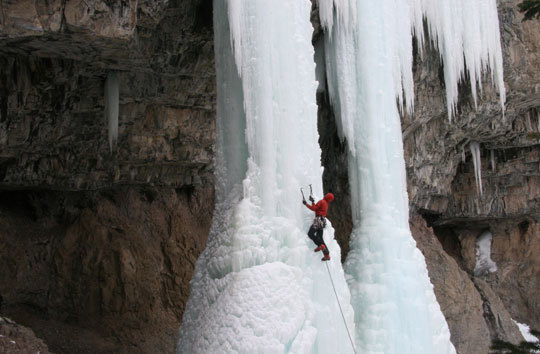
Will Wetzel leading View To A Thrill (WI5), South Fork, Cody, Wyoming. [Photo] Andrew Bardon
Through the website we have also drawn interest from military, first responder, police, and other tactical athletes. I’ve received e-mails and questions from Navy SEALs, soildiers deployed overseas, and Coast Guard Rescue Swimmers. In our gym we’ve trained members of the U.S. Secret Service and local law enforcement members.
I am constantly tweaking and improving my programming and exercise selection. One area we’ll be moving into is long, slow, endurance training. This type of training has to be completed outside the gym. I am currently researching how to combine endurance training like long runs and bike rides most effectively with the gym training.
Though our doors have been open just sixteen months now, I believe the hard training we are doing at Mountain Athlete is working to change the attitude and belief among many climbers, mountaineers, skiers, kayakers and all mountain athletes that training inside a gym is a waste of time.
I’ve always questioned the dogma that serious outdoors athletes shouldn’t lift weights and train hard in a gym when serious athletes in mainstream sports long ago embraced gym training as essential to reaching full potential in sport. Football players don’t just “play football” and sprinters don’t just “run fast” to train for their sports. They bust their asses in the gym and deploy that strength on the gridiron and track.
My athletes will prove this point for me. Propelled by hard-earned strength and conditioning in our gym, they are stronger longer, faster farther, and mentally tougher than those who “just climb” to train.
I’ll tell them to say “hello” and smile sweetly as they pass you on the way to the summit.

Mountain Athlete Tina Flowers at the Ruth Gorge in May 2008. [Photo] Nat Patridge